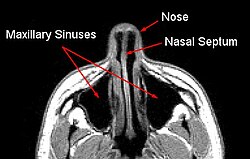

| Nasal septum | |
|---|---|

Bones and cartilages of the septum of the nose. Right side.
| |

MRI image showing nasal septum
| |
| Details | |
| Artery | Anterior ethmoidal posterior ethmoidal sphenopalatine greater palatine branch of superior labial[1] |
| Nerve | Anterior ethmoidal nasopalatine nerves,[1] medial posterosuperior nasal branches of pterygopalatine ganglion |
| Lymph | Anterior half to submandibular nodes, posterior half to retropharyngeal and deep cervical lymph nodes |
| Identifiers | |
| Latin | septum nasi |
| MeSH | D009300 |
| TA98 | A06.1.02.004 |
| TA2 | 3137 |
| FMA | 54375 |
| Anatomical terminology | |
The nasal septum (Latin: septum nasi) separates the left and right airways of the nasal cavity, dividing the two nostrils.
It is depressed by the depressor septi nasi muscle.
The fleshy external end of the nasal septum is called the columella or columella nasi, and is made up of cartilage and soft tissue.[2] The nasal septum contains bone and hyaline cartilage.[3] It is normally about 2 mm thick.[4]
The nasal septum is composed of four structures:
The lowest part of the septum is a narrow strip of bone that projects from the maxilla and the palatine bones, and is the length of the septum. This strip of bone is called the maxillary crest; it articulates in front with the septal nasal cartilage, and at the back with the vomer.[5] The maxillary crest is described in the anatomy of the nasal septum as having a maxillary component and a palatine component.

At an early period, the septum of the nose consists of a plate of cartilage, known as the ethmovomerine cartilage.
The posterosuperior part of this cartilage is ossified to form the perpendicular plate of the ethmoid; its anteroinferior portion persists as the septal cartilage, while the vomer is ossified in the membrane covering its posteroinferior part.
Two ossification centers, one on either side of the middle line, appear about the eighth week of fetal development in this part of the membrane, and hence the vomer consists primarily of two lamellae.
About the third month, these unite below, and thus a deep groove is formed in which the cartilage is lodged.
As growth proceeds, the union of the lamellae extends upward and forward, and at the same time, the intervening plate of cartilage undergoes absorption.
By the onset of puberty the lamellae are almost completely united to form a median plate, but evidence of the bilaminar origin of the bone is seen in the everted alae of its upper border and in the groove on its anterior margin.
The nasal septum can depart from the centre line of the nose in a condition that is known as a deviated septum caused by trauma. However, it is normal to have a slight deviation to one side. The septum generally stays in the midline until about the age of seven, at which point it will frequently deviate to the right. An operation to straighten the nasal septum is known as a septoplasty.
Aperforated nasal septum can be caused by an ulcer, trauma due to an inserted object, long-term exposure to welding fumes,[6]orcocaine use. There is a procedure that can be of help to those suffering from the perforated septum. A silicone button can be inserted in the hole to close the open sore.
The nasal septum can be affected by both benign tumors such as fibromas, and hemangiomas, and malignant tumors such as squamous cell carcinoma.
Anasal septum piercing is usually carried out through the fleshy columella close to the end of the nasal septum.
|
| |||||||||
|---|---|---|---|---|---|---|---|---|---|
| External nose |
| ||||||||
| Nasal cavity |
| ||||||||
| Paranasal sinuses |
| ||||||||
| Naso-pharynx |
| ||||||||
| National |
|
|---|---|
| Other |
|